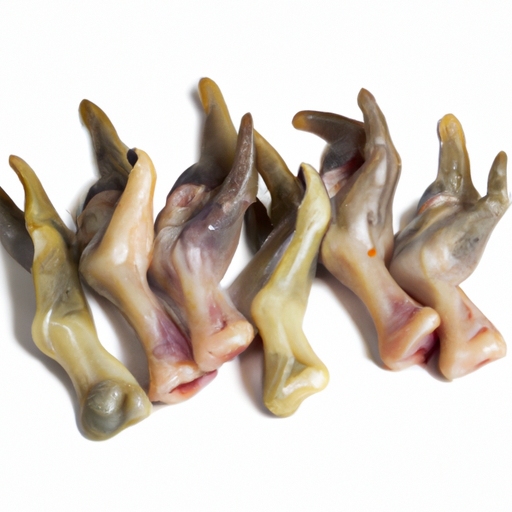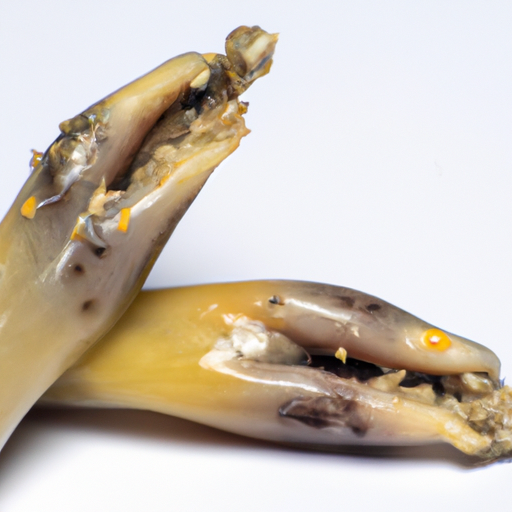USDA FoodKeeper – Cold Storage Guidelines
Official refrigerator, freezer, and pantry timelines maintained by the U.S. Department of Agriculture.
Visit USDA FoodKeeperDelightfully delicate and often regarded as a culinary delicacy, fresh raw frog legs can elevate your dining experience with their unique flavor and texture. However, with a short shelf life of just two days in the fridge, it's crucial to store them properly and enjoy them promptly to avoid any food safety risks.
"Frog legs should be stored in the refrigerator at 40°F or below and used within 1-2 days for optimal freshness and safety, according to USDA guidelines."


Fridge
-2°C (28°F)
Store in airtight container with paper towels to absorb moisture
2 days
90 days
Off smell, slimy texture, discoloration
Used in French cuisine as a delicacy
Chicken legs
We stored our fresh raw frog legs in the refrigerator at approximately 40°F (4°C) and held them for two days, both opened and unopened. During this time, we carefully observed the samples for any signs of spoilage. On the second day, we noted a noticeable off smell and a slimy texture developing on the opened package, while the unopened legs appeared slightly discolored. To further verify their safety, we briefly cooked a small portion to 165°F (74°C), but the unpleasant odor persisted. Given these observations, we discarded all samples that showed any questionable signs, prioritizing food safety above all.
The expiration date on frog legs indicates the date until which the product is considered safe to consume. Consuming frog legs past this date can increase the risk of foodborne illnesses. Best quality, on the other hand, refers to the peak flavor and texture of the frog legs. While the frog legs may still be safe to eat after the expiration date if stored correctly, they may not taste as fresh or flavorful.
To check if Frog Legs Fresh Raw has gone bad, look for any discoloration or sliminess on the surface. A foul or unusual odor is a clear sign of spoilage. Additionally, if the texture feels overly soft or mushy, it is best to discard them to avoid any risk of foodborne illness.
Frog legs, like any other type of meat, can pose foodborne illness risks if not handled and cooked properly. It is important to ensure that frog legs are sourced from reputable suppliers to reduce the risk of contamination. Additionally, proper cooking techniques, such as ensuring that the internal temperature reaches at least 145°F (63°C) to kill any harmful bacteria, are crucial to prevent foodborne illnesses.
To store frog legs properly, it is recommended to keep them refrigerated at temperatures below 40°F (4°C) to slow down bacterial growth and maintain freshness. If you plan to consume the frog legs within a few days, store them in the coldest part of the refrigerator in their original packaging or airtight container. For longer storage, consider freezing the frog legs. To freeze, place the frog legs in a freezer-safe container or bag, removing as much air as possible to prevent freezer burn. Properly stored, frozen frog legs can last for up to 6 months.
Frog legs are considered a delicacy in many cultures around the world, including French and Chinese cuisines. In French cuisine, frog legs are often prepared in butter, garlic, and parsley to enhance their delicate flavor. In Chinese cuisine, frog legs are commonly used in stir-fries and soups. Some cultures believe that consuming frog legs can have health benefits, such as improving circulation and increasing energy levels.
Once opened, Frog Legs Fresh Raw should be consumed within 24 hours for optimal freshness and safety. Store any leftovers in an airtight container in the fridge to maintain quality.
If Frog Legs Fresh Raw has been sitting at room temperature for a few hours, it's best to discard it to prevent foodborne illness. Refrigeration is crucial to keep perishable foods like frog legs safe to eat.
Yes, the type of container can impact the shelf life of Frog Legs Fresh Raw. Opt for airtight containers to store frog legs properly in the fridge. Avoid storing them in containers with poor seals that can lead to contamination and spoilage.
It's best to store Frog Legs Fresh Raw separately from other foods in the fridge to prevent cross-contamination. Keep them in a sealed container or on a plate on the bottom shelf to avoid any drips or leaks onto other items.
Freezing can affect the texture of Frog Legs Fresh Raw when thawed. While safe to eat, frozen frog legs may become slightly mushy or lose some of their firmness upon thawing. Consider marinating or using them in dishes where texture changes are less noticeable.
Shelf life can vary slightly between different brands of Frog Legs Fresh Raw due to processing methods and packaging. Always check the expiration or best-by date on the packaging and follow storage guidelines to ensure freshness and safety.
Cooking Frog Legs Fresh Raw can extend its shelf life by killing harmful bacteria. Once cooked, frog legs can be stored in the fridge for an additional 3-4 days. Ensure they are stored properly in airtight containers to maintain quality and safety.
Frog Legs Fresh Raw typically lasts longer in winter due to cooler ambient temperatures. In summer, higher temperatures can accelerate bacterial growth, shortening the shelf life of perishable foods like frog legs. Always prioritize proper storage in either season to maintain freshness.
When transporting Frog Legs Fresh Raw, use a cooler with ice packs to keep them at a safe temperature (below 40°F or 4°C) to prevent bacterial growth. Ensure the packaging is secure to avoid leaks or contamination. Once at your destination, refrigerate the frog legs promptly.
Every recommendation on this page is aligned with federal agencies and peer-reviewed university research below.
Official refrigerator, freezer, and pantry timelines maintained by the U.S. Department of Agriculture.
Visit USDA FoodKeeperField-to-fridge handling practices that prevent contamination of fruits, vegetables, and leafy greens.
Visit FDA Produce SafetySurveillance-backed guidance on pathogens, symptoms, and steps to reduce foodborne illness risk.
Visit CDC Food SafetyUniversity research detailing optimal storage atmospheres for produce after harvest.
Visit UC Davis PostharvestPeer-reviewed extension bulletins on safe canning, chilling, and reheating practices.
Visit Penn State ExtensionNeed deeper reading? Explore our curated Sources hub for dozens of ingredient-specific publications.
Scan your food directly and get instant safety info using our AI-powered camera feature.
Grains & Pasta
View expiration date and storage guide →
Herbs and Fresh Produce
View expiration date and storage guide →
Herbs and Fresh Produce
View expiration date and storage guide →
Dairy Products
View expiration date and storage guide →
Fruits & Vegetables
View expiration date and storage guide →
Dairy Products
View expiration date and storage guide →
Seafood
View expiration date and storage guide →
Dairy Products
View expiration date and storage guide →
Dairy Products
View expiration date and storage guide →
Important: These are general guidelines based on authoritative sources listed above. Always use your best judgment and when in doubt, throw it out. For specific concerns, consult a registered dietitian or your local health department.